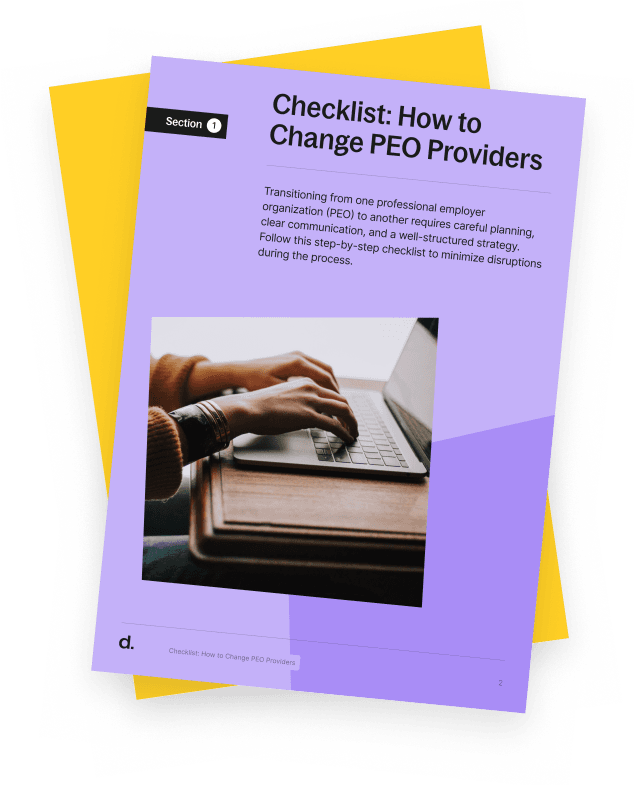Article
10 min read
How to Save Costs and Admin Time With A PEO Health Plan
PEO

Author
Dr Kristine Lennie
Last Update
June 28, 2025

Table of Contents
Health insurance buying channels: A practical overview
What is a PEO health plan?
Who should consider a PEO health plan?
How can PEO health plans save you time and costs?
Your PEO provider questions checklist: Choosing the right partner for your health plan needs
Boost your healthcare benefits with Deel PEO
Key takeaways
- Healthcare plans are one of the most desirable benefits a US employer can offer—but also one of the costliest.
- A professional employer organization (PEO) is an HR outsourcing model that not only streamlines your people ops but also enables you to access high-caliber health benefit options at a fraction of the cost.
- Deel PEO is a strategic solution that unlocks premium health benefits at large-group rates, while taking on your payroll, tax, and compliance responsibilities so you can focus on scaling your business.
Small and medium-sized businesses often face steep competition from larger enterprises when it comes to attracting and retaining top talent. To stand out, employers must offer more than competitive salaries—they also need to have a compelling benefits package. A key component of this is great healthcare.
According to a 2024 survey by Forbes, two-thirds of employees consider health insurance to be the most important employment benefit that companies can provide. However, it is also one of the costliest. In 2024, the average annual cost of single coverage was estimated at $9,000 USD, with a family plan exceeding $25,000.. Founders and HR teams need to balance these costs against plan limitations and employees’ expectations.
One possible solution is to partner with a professional employer organization (PEO)—an HR model that acts as a co-employer and unlocks access to employment benefits at prices typically reserved for larger organizations. In this article, we break down how PEO health plans can boost your benefits package while saving you costs and admin time.
Choosing the right PEO for your business needs can be challenging. Compare the best PEOs for small businesses in 2025.

Health insurance buying channels: A practical overview
When it comes to purchasing health insurance, employers have several options available to them:
- Directly from insurers: This involves finding and purchasing a group plan directly through an insurance company
- Health insurance marketplaces or exchanges: These are private or government-led platforms where employers can compare, select, purchase, and sometimes manage their healthcare plans
- Insurance brokers or agents: This option involves third-party experts who help evaluate plans, guide decision-making, and manage the enrollment process for a fee
- PEO health plans: PEOs provide large-group insurance rates for their clients, alongside HR, payroll, tax, and compliance services
Here’s a summary of the key differences to help you compare types of purchasing channels:
| Method | Multiple carriers | Negotiation/customization | Price | Best for |
|---|---|---|---|---|
| Directly from the insurer | No | Minimal | Higher | Small organizations that prefer a specific insurance provider |
| Marketplaces/ exchanges | Yes | Minimal | Medium | Very small businesses seeking Affordable Care Act (ACA)-compliant plans |
| Insurance brokers/ agents | Yes | Moderate | Medium | Small and mid-sized businesses looking for expert guidance and access to a variety of plans |
| PEO health plans | Yes (group rates) | Moderate | Lower | Small and mid-sized businesses aiming to reduce costs and integrate HR solutions |
Deel PEO
What is a PEO health plan?
A PEO health plan is a group health insurance plan that becomes available to companies that engage PEO services. When partnering with a PEO, businesses enter into a co-employment agreement in which the PEO assumes responsibility for HR, payroll, administrative, and compliance functions, while the client manages the business’s daily operations. Because PEOs serve multiple clients, they can pool workforces to negotiate access to large-group benefits through economies of scale. This arrangement allows the employees to choose from a variety of plans with different co-pays and deductibles, and select the coverage that best suits their needs.
What does a PEO health plan typically include?
Many PEOs offer major medical coverage, widely considered the strongest foundational health insurance coverage a US employer can provide. These plans are ACA-compliant, meaning they cover a wide range of essential medical services, including hospitalization, surgeries, preventive care, and more. In addition to physical health benefits, ACA-compliant plans also include mental health services such as therapy, counseling, and psychiatric care.
Add-ons
Aside from competitive core health plans, PEOs typically offer health insurance add-ons that provide employees with financial protection for various medical expenses. Popular options include:
- Dental and vision coverage: An optional add-on that covers oral and eye health treatments, including exams, procedures, and corrective lenses
- Critical illness insurance: Supplemental coverage that pays a lump sum if the beneficiary is diagnosed with a covered illness
- Accident insurance: Provides a lump sum payout if the employee suffers an injury due to a covered accident
- Hospital indemnity insurance: Pays a fixed amount upon admission to a hospital, and a daily benefit for each additional day spent in the hospital (up to a predefined limit)
Healthcare savings accounts
Healthcare savings accounts are another type of benefit that PEOs can offer employees. These are tax-advantaged savings accounts that help employees set aside pre-tax money to pay for qualified medical expenses. Common examples of these are:
- High-Deductible Health Plan (HDHP) and Health Savings Account (HSA): HDHPs feature lower monthly premiums but higher deductibles, and are often paired with HSAs—tax-free accounts for saving and spending money on qualified medical expenses
- Flexible Spending Account (FSA): This account also allows employees to save pre-tax money for medical or childcare costs, but many include a ‘use-it-or-lose-it’ clause for each year
HR compliance and administrative tools
With a PEO co-employment model, businesses receive more than an expanded portfolio of health insurance options. PEOs also take on benefits-related administrative and regulatory functions, including:
- Managing healthcare compliance: PEOs ensure alignment with federal, state, and local laws, including compliance with the ACA, Consolidated Omnibus Budget Reconciliation Act (COBRA), and the Health Insurance Portability and Accountability Act (HIPAA)
- Handling employee enrollment and documentation: PEOs take on all back-office tasks related to benefits management, including enrollment, eligibility tracking, and maintaining up-to-date employee records
- Centralized HR support and self-service tools: PEOs typically offer a centralized help desk for benefits-related questions, while also equipping employees with self-service portals to independently view, update, and manage their health plans
PEO health plans vs. regular small group plans
When evaluating your options for health benefit plans, it's important to consider not just the cost but also the coverage flexibility, administrative burden, compliance requirements, and employee experience. Here’s how traditional group plans and PEO health plans compare:
| Feature | Traditional group plan | PEO health plan |
|---|---|---|
| Network access | Limited access to regional carriers | Broad access to national, enterprise-level carrier networks |
| Plan customization and coverage | Limited plan choices and minimal customization options for employees | Multiple medical plan options with optional add-ons such as dental, vision, HSAs, FSAs, and supplemental benefits |
| Group scale advantage | Limited negotiating power due to the small number of employees | Larger pooled risk enables reduced premiums |
| Cost volatility | Higher and more volatile, with annual rate hikes and limited predictability | More stable pricing, with smoothed renewals and long-term forecasting |
| Cost efficiency | Lower upfront pricing, but with separate contracts and fees for brokers, software, and admin tools | Higher upfront cost, but advantageous long-term, with bundled pricing for HR, payroll, and benefits plans, and admin |
| Administrative burden | HR or the business owner typically manages benefits and related tasks | Offloaded to the PEO through a centralized service |
| Compliance management | Managed in-house or broker-supported, with the employer responsible for compliance and filing | The PEO manages payroll and HR compliance responsibilities, including ACA, COBRA, and HIPAA |
| HR technology and onboarding | Often fragmented and dependent on third-party platforms | Unified platform for onboarding, payroll, compliance, and benefits management (with Deel) |
| Benefits enrollment experience | Manual processes or non-integrated systems | Self-service portals for streamlined employee enrollment and plan management (with Deel) |
| Employee experience | Less centralized and consistent, often lacking robust support systems | Enhanced support, user-friendly tools, and centralized access to benefits (with Deel) |
| Employee engagement and retention | Lower utilization, with less visibility into benefits information and management | Higher engagement and satisfaction through better onboarding and benefits access |
| Strategic value | Standalone health insurance | Comprehensive HR and benefits solution that supports growth (with Deel) |
Global Hiring Toolkit
Who should consider a PEO health plan?
For fast-growing businesses with multiple competing priorities, partnering with a PEO can be an advantageous way to access high-quality benefits and streamline back-office tasks. Consider a PEO health plan if:
- You need predictable, cost-effective health benefits that scale with your team, without additional hidden fees or unexpected rate hikes
- You are seeking to boost your competitive edge in the talent market or improve employee retention without adding operational complexity
- You want to reduce the risk and administrative burden of complying with ACA, HIPAA, and COBRA
- Your workforce spans multiple states, and you’re unsure how to remain compliant across jurisdictions
- You lack a dedicated HR team but expect rapid growth, and can't afford benefits errors or delays
See also: PEO Services: A State-by-State Guide for US Employers
How can PEO health plans save you time and costs?
A PEO co-employment model may involve some upfront costs and contractual commitments, such as a monthly fee and a service agreement. However, over time, PEOs often deliver significant savings in both cost and administrative effort. When it comes to health plans and employee benefits, there are several ways in which partnering with a PEO can bring you value:
How can a PEO health plan help you cut costs?
A PEO partnership offers small and mid-sized businesses several effective ways to cut costs and avoid legal penalties or unexpected fees:
- Large-group rates: PEOs pool employees from multiple small businesses, giving you access to health insurance rates typically reserved for large employers
- Minimized legal risks: PEOs take on benefits compliance responsibilities, helping businesses avoid costly fines and regulatory risks by ensuring alignment with ACA, HIPAA, and COBRA requirements
- Fewer claim disputes: PEOs manage claims processing on behalf of your employees, helping them resolve issues faster, avoid out-of-network charges, and minimize costly billing errors
- Predictable, transparent pricing: Choosing a PEO provider that offers transparent and predictable bundle pricing can reduce unexpected budget strain and improve your long-term financial planning
- Reduced broker and third-party admin fees: PEOs handle benefits negotiation, admin, and enrollment, eliminating the need to pay separate brokers, third-party administrators, or consultants
How can a PEO health plan save you time?
PEO health plans offer a cost-effective solution for enhancing your benefits package while spending less per employee than with a traditional small-group plan. However, partnering with a PEO delivers more than just enhanced benefits. Here are some key ways in which a co-employment relationship with the right PEO can save you valuable time:
- Streamlined, centralized benefits administration: PEOs handle all benefits-related admin, from plan selection support for employees to managing open enrollment periods, qualifying life events, and other relevant responsibilities throughout the year
- Compliance tracking: PEOs take over time-consuming compliance tasks—such as tracking employee benefits eligibility and managing regulatory requirements—so your team can focus on more strategic work
- Optimized onboarding: PEOs’ systems typically integrate HR, benefits, and payroll functions, allowing faster employee setup and benefits enrollment
- A single point of contact: PEOs provide a unified source for all benefits-related services, cutting down on the time cost of managing multiple vendors, brokers, or legal experts
- Employee self-service portals: PEOs typically equip employees with self-service portals to manage key aspects of their benefits and the enrollment process, reducing the HR workload and enhancing the overall employee experience
- Faster issue resolution: PEOs' in-house support means employee issues get resolved quicker, reducing downtime and complaints
Using a PEO provider goes beyond enhancing your benefits package or reducing your admin. With a co-employment model, you can outsource your tax filing and payroll, offload your core HR operations, and streamline compliance. Learn how Deel is redefining the PEO experience with our fully in-house solution.
Your PEO provider questions checklist: Choosing the right partner for your health plan needs
Evaluating different PEO providers can be challenging, especially when trying to understand their full range of services and pricing models. To help you navigate the decision-making process, we’ve created a table of essential questions that you can use to compare providers, clarify what’s included in their bundle, and identify the partner best equipped to support your team’s health coverage needs:
| Category | Key questions | Why it matters |
|---|---|---|
| Health plan types | What types of health benefits plans do you offer? | A variety of plan types ensures you can offer your employees the right options to match their personal and financial needs |
| Carrier access | Do you work with national or regional insurance carriers? | Access to established, widely accepted carriers helps ensure quality service |
| Plan customization | Can benefits be tailored to employees’ needs or budget? | Better customization allows employees to choose the option that best fits their lifestyle, demographics, and finances |
| Cost structure | Do you charge flat fees or a percentage of payroll? | Clarifying the underlying billing model will help you understand long-term affordability |
| What is included | Are there additional fees for plan administration or support services? | Establishing what services are bundled or billed separately will allow you to avoid surprise costs |
| Eligibility and participation | What are your minimum participation requirements? | Ensure your team can meet the thresholds for offering coverage |
| Implementation and onboarding duration | How long does implementation and onboarding typically take? | Knowing the onboarding timeline helps you plan for the transition and ensure minimal disruption to your day-to-day processes |
| Renewal and rate history | What’s your historical average for annual premium increases? | Understanding how pricing might change helps with budgeting and long-term strategy |
| Platform and tools | Can you show me a quick demo of the platform? | A demo of the platform helps you evaluate how intuitive and user-friendly it is, and if it requires a steep learning curve |
| System integrations | Can your platform integrate with existing payroll or HR systems? | A unified platform that easily integrates with different software will ensure a smooth transition and improve data accuracy |
| Support model | Do you provide in-house advisors and legal or compliance experts? | In-house support improves efficiency and helps resolve issues quickly without the need for external help |
| Support response time | What’s your average response time for support inquiries? | An efficient and centralized help desk for dealing with employee issues means smoother day-to-day operations. |
| Benefits administration | Do you manage benefits-related admin? | Better admin support will offload routine tasks from your internal team |
| Compliance expertise | How do you help with ACA, HIPAA, and COBRA compliance? | A fully managed compliance service will reduce legal risk and ensure ongoing regulatory alignment |
| Employee claims support | Do you assist employees with billing disputes or insurance questions? | A more comprehensive support improves employee experience and reduces HR workload |
Learn more: How to Choose the Best PEO for Health Insurance.

Boost your healthcare benefits with Deel PEO
Health insurance is essential for attracting talent, but premium plans are often out of reach for growing businesses focused on cost control.
With Deel PEO, you gain instant access to 60+ domestic benefits plans and the Aetna International benefits plans—exclusive to Deel. By partnering with Deel, you can provide extensive, high-quality coverage for your US teams without the cost of a Fortune 500-level package.
Deel PEO is not just a benefits and admin service but a strategic solution trusted by more than 35,000 clients worldwide. Our fully in-house infrastructure saves you time and money by providing you with:
- Extensive benefits offering, end-to-end admin support, and seamless compliance management
- Comprehensive payroll administration
- Built-in compliance tools that streamline regulatory processes in all 50 states
- Automated tax processing and filing at the federal, state, and local levels
- Transparent pricing with no hidden costs or additional fees
- And more
Discover how Deel PEO helps you reduce your benefits and admin costs. Book a demo to learn more.
This article is intended for informational purposes and should not be considered legal advice. Consult a qualified licensed attorney for help on legal issues.
FAQs
What are the pros and cons of a PEO?
There are many benefits of using a PEO service, such as better benefits, simplified HR, streamlined payroll, and offloaded compliance management. However, PEOs require a co-employment arrangement, which may involve ceding some control over HR processes and adapting to the PEO’s systems and setup. Ultimately, whether a PEO is right for your business depends on your specific needs, priorities, and long-term goals.
Unsure if a PEO model is the right choice for you? Read ASO vs. PEO: Which is Right for Your Business?.
Is a PEO a joint employer?
A PEO is a co-employer. Under a co-employment model, both the client and the PEO share responsibilities. The PEO takes over HR functions, payroll, benefits, and compliance, while the client manages the day-to-day operations of running the business.
Does a PEO save money?
PEOs typically involve a higher upfront cost for clients, but save money in the long run by securing better rates on benefits, reducing employee turnover, minimizing legal risks and compliance penalties, and streamlining processes such as HR, payroll, and admin. PEOs also tend to provide a full package of services, eliminating the need for additional third parties and the associated expenses.
What is the difference between a PEO and a payroll company?
Payroll companies are third-party providers that handle basic payroll functions such as wage processing, tax filing, and payroll-related compliance. PEOs, on the other hand, enter into a co-employment relationship with their clients. This arrangement allows PEOs to offer a broader range of services—including HR, benefits, compliance, and risk management—while also sharing certain employer liabilities with the client company. Keep exploring the differences between PEO and payroll companies.

Dr Kristine Lennie holds a PhD in Mathematical Biology and loves learning, research and content creation. She had written academic, creative and industry-related content and enjoys exploring new topics and ideas. She is passionate about helping create a truly global workforce, where employers and employees are not limited by borders to achieve success.















